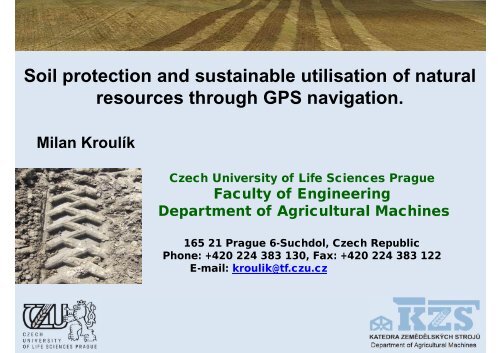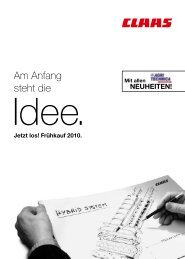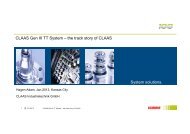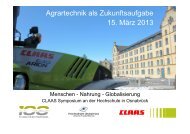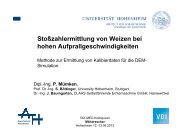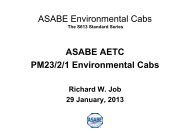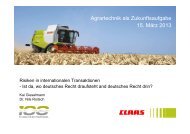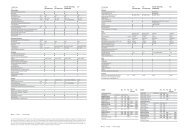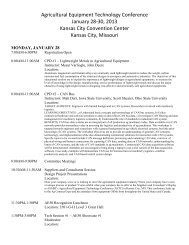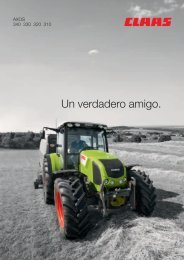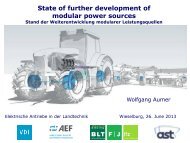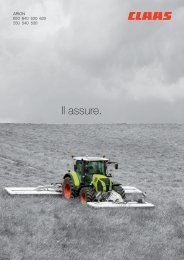1 Milan Kroulik Slides - website
1 Milan Kroulik Slides - website
1 Milan Kroulik Slides - website
Create successful ePaper yourself
Turn your PDF publications into a flip-book with our unique Google optimized e-Paper software.
Soil protection and sustainable utilisation of natural<br />
resources through GPS navigation.<br />
<strong>Milan</strong> Kroulík<br />
Czech University of Life Sciences Prague<br />
Faculty of Engineering<br />
Department of Agricultural Machines<br />
165 21 Prague 6-Suchdol, Czech Republic<br />
Phone: +420 224 383 130, Fax: +420 224 383 122<br />
E-mail: kroulik@tf.czu.cz
The global problems connected with soil conditions<br />
‐ soil erosion (still increasing worldwide),<br />
‐ soil compaction (particularly in developed countries using big and<br />
heavy machinery in fields.<br />
Soil erosion and compaction by machinery traffic is one of the major<br />
problems facing modern agriculture and it is a well‐recognised<br />
problem worldwide.
With today’s emphasis on intelligent and<br />
sustainable farming methods, satellite<br />
navigation for agricultural machinery is essential.<br />
Machinery manufacturers, mainly tractor and<br />
harvester producers, offer several variants for<br />
automatic steering and navigation.
Current issues of the intensive management and its<br />
influence on agricultural land and remedial measures<br />
Soil compaction is primarily most frequently been associated with the field<br />
operations of heavy machines.<br />
Soil<br />
compaction<br />
Erosion<br />
Field condition aptly shows an aerial image
In today´s agriculture: the machinery passes are inevitable<br />
randomly organized traffic
Real operating conditions using a conventional tillage system<br />
with ploughing and also a conservation tillage system<br />
Conventional system with ploughing<br />
Conservation tillage
PLOUGHING<br />
CONSERVATION<br />
TOTAL WHEELED AREA 86,14% 63,75%
Frequency of agricultural machinery passes on HEADLANDS<br />
(headland width 25 m)<br />
Conventional system<br />
with ploughing<br />
Run-over area<br />
(%)<br />
Conservation tillage<br />
Run-over area<br />
(%)<br />
Number of passes repetitions<br />
Number of passes repetitions<br />
1x<br />
2x<br />
3x<br />
4x<br />
5x<br />
6x and more<br />
17.09<br />
25.70<br />
23.99<br />
15.08<br />
8.50<br />
3.83<br />
1x<br />
2x<br />
3x<br />
4x<br />
5x<br />
6x<br />
30.23<br />
31.16<br />
15.86<br />
4.05<br />
0.46<br />
0.01<br />
Run-over area (total) (%) 86.14 Run-over area (total) (%) 81.76
Conservation tillage ‐ 8 m fixed track system<br />
Technical solution of the same wheelbase or tracks could be a major obstacle. Without<br />
costly measures in the form of expansion of wheelbases and likewise can be achieved at the<br />
same intensity of the work a significant reduction in the frequency of passes.
Frequency of machinery passes across a field where fixed tracks<br />
were used.<br />
Conservation tillage<br />
4 m working width<br />
Run-over area<br />
(%)<br />
Conservation tillage<br />
8 m working width<br />
Run-over area<br />
(%)<br />
Number of passes repetitions<br />
Number of passes repetitions<br />
1x<br />
2x<br />
3x<br />
4x<br />
5x<br />
6x<br />
4.58<br />
3.24<br />
5.18<br />
16.51<br />
0.16<br />
7.71<br />
1x<br />
2x<br />
3x<br />
4x<br />
5x<br />
6x and more<br />
10.38<br />
0.00<br />
8.46<br />
7.65<br />
1.36<br />
3.03<br />
Run-over area (total) (%) 37.38 Run-over area (total) (%) 30.88
Intensity of random machinery passes influences also grassland or<br />
fields with perennial crops<br />
63.8 %<br />
63.4 %
PARTIAL OUTCOMES<br />
Farming practices – chosen tillage technology ‐ can significantly effect final<br />
intensity of traffic in the fields throughout a cropping season.<br />
TAKING INTO ACCOUNT LITERATURE SOURCES<br />
Intensity of traffic (number of machinery passes) in fields plays an important role in soil<br />
compaction, because soil deformations can increase with the number of passes.<br />
However, the first pass of a wheel is known to cause a major portion of the total soil<br />
compaction.<br />
IDEA DERIVED FROM PREVIOUS INFORMATION<br />
One possible tool for (further) machinery traffic reduction and therefore soil compaction<br />
reduction could be the fixed track system.
“Soil compaction phenomenon is connected with number of machinery passes but also with<br />
time exposure of soil surface to contact pressure”<br />
Interesting outcome –the map of soil exposure to machinery time‐dependent presence<br />
(tyres contact presure) – visible spots where machinery stayed for a longer time (i.e.<br />
seeder loading, sprayer filling up…)‐ the more log‐impulses recorded at a particular place<br />
the darker colour in the map<br />
greater risk of compaction<br />
Map characterising intensity of traffic and<br />
time spent at a certain area
PARTIAL OUTCOMES<br />
It is very difficult to locate and rationalize soil compaction, because marks on the soil<br />
surface are not evident.<br />
GPS (global positioning system) receiver as simple equipment of a tractor can be used for<br />
detection of areas in the field where multiple trafficking appears.<br />
IDEA DERIVED FROM PREVIOUS INFORMATION<br />
Based on knowledge of the load intensity is possible to optimize the depth of loosening<br />
pursuant maps of passes. From figure most exposed areas by loads are headlands and<br />
areas where the machines were weaned.
Logistic solution of transport trailer<br />
A number of field operations are dependent on the support of conveyance<br />
and requires cooperation when working with these machines.<br />
Recordings made during the work of machines showed a number of reserves<br />
and deficiencies in these activities.<br />
The empty conveyance follows the forage harvester trailer
PARTIAL OUTCOMES<br />
In presented results, tractor with an empty trailer followed tractor operating with a<br />
chopper at all times.<br />
Bales collection is organized according to the estimate of the manipulator operator.<br />
IDEA DERIVED FROM PREVIOUS INFORMATION<br />
Better organization and cooperation of transport trailer with chopper would certainly<br />
help to reduce the repeated crossings.<br />
With knowledge of the position of bales is possible use the method of linear<br />
programming to design haul route with the requirement for the shortest travelled<br />
distance.
Optimizing production areas of land<br />
With irregular shapes of the fields or with curved sides; increases the number of<br />
passes, turns, overlaps or omissions.<br />
23.6 ha
To obtain economic nature information about the field or information about the<br />
operation of machines is relative simple.<br />
yield monitoring<br />
market<br />
and prices<br />
process parameters<br />
of working machines<br />
plant and soil condition<br />
field history and<br />
managment
PARTIAL OUTCOMES<br />
No small facilities are spent on the soil preparation each year. Nevertheless, endeavour of<br />
the farmers doesn't need to bring required results.<br />
The driver has to make a greater effort to treat or process these marginal areas and<br />
corners of the field. Especially the headlands are exposed to increased intensity of passes.<br />
Monitoring of process parameters of working machines especially during tillage is easy<br />
due to modern tractors and electronic equipment.<br />
Crop yield monitoring is one of the most widespread applications of precision farming.
IDEA DERIVED FROM PREVIOUS INFORMATION<br />
What extent is appropriate intensively cultivated these areas or deal with remedial<br />
measures?<br />
Establishment of grassland on these areas would allow better pass ability during turns.<br />
It would also minimize overlaps or omissions during establishment or maintenance of<br />
vegetation.<br />
Grassy vegetation would also form a barrier against water runoff from the sloping fields.<br />
Defined areas can be prepared in the form of polygons with which the navigations can<br />
operate and control sowing sections.
Route planning and optimization of machine sets for land<br />
The field shape, size, terrain, obstructions and size of the equipment have greatest influence on<br />
performing operational steps from the point of view of exploitation, economical and energy<br />
criteria.
At present, trajectories are<br />
based especially on the<br />
experience of drivers or usual<br />
habits of farmers.<br />
approximately 90°<br />
Optimal trajectory of guidance line<br />
100°
Influence of the direction of movement at a known shape of land on working<br />
efficiency of machine sets.<br />
Plot A, turning the machine set without<br />
opposite turns<br />
Plot A, turning the machine set with<br />
opposite turns
Length of driving distance for the different directions of trajectories
PARTIAL OUTCOMES<br />
Field, where two sides are not parallel, is<br />
adopted as a standard in farm models.<br />
The trajectories model does not respect the slope of the land.<br />
IDEA DERIVED FROM PREVIOUS INFORMATION<br />
Even minimum deviation from optimal route can lead to a significant increase of nonworking<br />
trips and passes.<br />
Trajectory model can be, quite easily, transferred into the guidance.<br />
It is necessary to focus further work on development of working models of route<br />
trajectories that would also take into account the shape of the land with emphasis on<br />
erosion mitigation and with the possibilities of agricultural machinery pass ability.<br />
These trajectories should be available from relevant <strong>website</strong>s for the navigation devices.
Delimitation of areas with increased risk of erosion<br />
1953<br />
2000
The need to eliminate the above risks is legally enshrined in the documents<br />
of the European Communities (Council Regulation (ES) No. 73/2009).<br />
These societal requirements are implemented in the GAEC standards<br />
(Good Agricultural and Environmental Conditions).<br />
Every farmer in the Czech Republic<br />
has an overview of their lands on the<br />
web portal LPIS of the Ministry of<br />
Agriculture.
Picture describes the situation model of the field<br />
Terrain and slope models<br />
Soil erosion model predicts the spatiotemporal<br />
distribution of erosion and deposition as well<br />
as the delivery of suspended soil material to<br />
surface water courses on a watershed scale.<br />
Identification of the areas with erosion risk.
Erosion zone is plotted back to the portal LPIS<br />
The farmer will be able to generate area for use in the navigation system.
PARTIAL OUTCOMES<br />
The available data for terrain and erosion modelling can be obtained from GPS receivers<br />
during previous work on the land.<br />
Farmers have available information and proposals through the portal LPIS.<br />
IDEA DERIVED FROM PREVIOUS INFORMATION<br />
Based on the transmitted information the navigation system will be able to manage<br />
tasks for the required anti‐erosion and soil protection interventions.<br />
Along with selecting the optimal route the navigation system could significantly<br />
promote erosion control and soil retention capacity of the land<br />
Guarantee of compliance and meeting the requirements of the erosion control<br />
measures for the control authorities.
Conclusion:<br />
• There were introduced the possibilities how to use the position of the<br />
machines to reduce the passes risk factors with minimal additional cost of<br />
agriculture machine equipment.
Very final advice:<br />
„ALWAYS USE THE RIGHT TRACKS!!!“
Thank you for attention<br />
<strong>Milan</strong> Kroulík<br />
Czech University of Life Sciences Prague<br />
Faculty of Engineering<br />
Department of Agricultural Machines<br />
165 21 Prague 6-Suchdol, Czech Republic<br />
Phone: +420 224 383 130, Fax: +420 224 383 122<br />
E-mail: kroulik@tf.czu.cz


